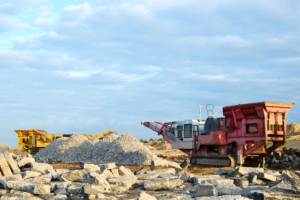Here are 3 of the most common rare earths and the ASX stocks exposed to them

In this article, we recap some of the most common rare earths (not so rare earths) and some of the ASX stocks that are right in the thick of them.
What are rare earths?
Rare earths are a group of 17 elements found on the periodic table that have unique magnetic, luminescent, and catalytic properties. These elements include lanthanum, cerium, praseodymium, neodymium, promethium, samarium, europium, gadolinium, terbium, dysprosium, holmium, erbium, thulium ytterbium lutetium and scandium.
These elements aren’t called rare because they literally are rare – most of them are abundant. However, they are so-called ‘rare’ because of dispersed nature in the earth’s crust. They are typically found in very small concentrations or even trace amounts within other minerals or ore bodies. They are also difficult to extract and process due to their chemical reactivity.
What are rare earths used for?
The modern applications of these rare earths span across many industries, such as renewable energy sources like hybrid car batteries and wind turbines. They are also used extensively in medical imaging technology, such as X-ray machines and MRI scanners.
Rare earths can also be found in fluorescent lighting fixtures and optical lenses for cameras. Additionally, they offer essential components for military equipment such as radar systems and laser guidance devices.
What are the most common rare earths?
1. Neodymium
Neodymium is a rare earth element with the symbol Nd and atomic number 60. It is used in various industrial and electronic applications, such as high-strength permanent magnets, laser lenses, optical storage media, water purifiers and air filtration systems. It is also used to create blue glass that absorbs infrared radiation.
Neodymium has a wide range of uses in many industries due to its unique properties of providing strong magnetic fields while being lightweight and relatively inexpensive.
2. Scandium (Sc)
Scandium is a silvery-white metallic element with the atomic number 21. It is chemically similar to yttrium and rare-earth elements, and has many of the same uses, including in fluorescent lamps, explosives detectors, lasers, metal halide lamps for grow lights and film projectors.
Scandium also has unique properties that make it excellent for use in high-strength alloys used to manufacture aircraft components such as bicycle frames and golf club shafts.
Additionally, scandium oxide can be added to aluminium alloys used in aerospace structures to increase their strength without adding significant weight.
3. Lanthanum
Lanthanum is a chemical element in the lanthanide group of elements with symbol La and atomic number 57. It is used in ceramics, phosphors, electronic catalyst supports, specialty glass lenses, catalytic converters and other applications.
Lanthanum also has several medical uses including the treatment of kidney stones. Furthermore, it can absorb hydrogen to form an alloy that can be used as an injectable material for radiotherapy treatments of cancer tumors.
Stocks in the thick of it
First of all, there’s Lynas (ASX: LYC). LYC is not just the most prominent rare earth stock on the ASX, but also one of the world’s largest producers of rare earths outside of China.
Then there are nearly a dozen explorers that are aspiring to become producers.
- American Rare Earths (ASX:ARR) has La Paz Rare Earths Project in Arizona.
- Australian Strategic Materials (ASX: ASM) has recently shown some great progress with its Dubbo project in western NSW.
- Hastings Technology Metals (ASX: HAS) is getting close with its Yangibana project in the Gascoyne region of WA.
- Ionic Rare Earths (ASX: IXR) probably has the best geology out there for easy-to-obtain rare earths in its Makuutu Project in Uganda.
- Northern Minerals (ASX: NTU) reckons it has the right stuff with its Browns Range project in WA’s Kimberley Region.
- Peak Resources (ASX: PEK) has also done feasibility work on its Ngualla project in Tanzania.
- RareX (ASX: REE) has a rapidly expanding deposit at Cummins Range project in WA’s Kimberley region and;
- Vital Metals (ASX: VML) has the Nechalacho project in Canada’s Northwest Territories as its flagship.
Which stocks should you invest in?
In our view, investors will be least likely to go wrong with Lynas. This is not just because it is a producer, but because it is essentially the only major producer of outside China and its product is likely to be pursued by Western countries seeking to build their own reliable supply chains of critical minerals.
What are the Best ASX Resources Stocks to invest in right now?
Check our buy/sell tips
Blog Categories
Get Our Top 5 ASX Stocks for FY26
Recent Posts
Develop Global Wins $200m OceanaGold Contract- What It Means for Investors
Develop Global (ASX: DVP) climbed 4% to A$4.36 on Friday after securing a A$200 million underground development contract with global…
Nova Minerals Drops 14% on $20m Capital Raise- Buy or Avoid?
Nova Minerals (ASX: NVA) dropped nearly 14 per cent to A$0.90 following the announcement of a US$20 million (approximately AUD…
WiseTech (ASX:WTC) Rises After Richard White Cleared of Misconduct – Should You Buy the Dip?
WiseTech Global (ASX: WTC) climbed 3 per cent to A$70.18 on Friday after founder and Executive Chairman Richard White was…



